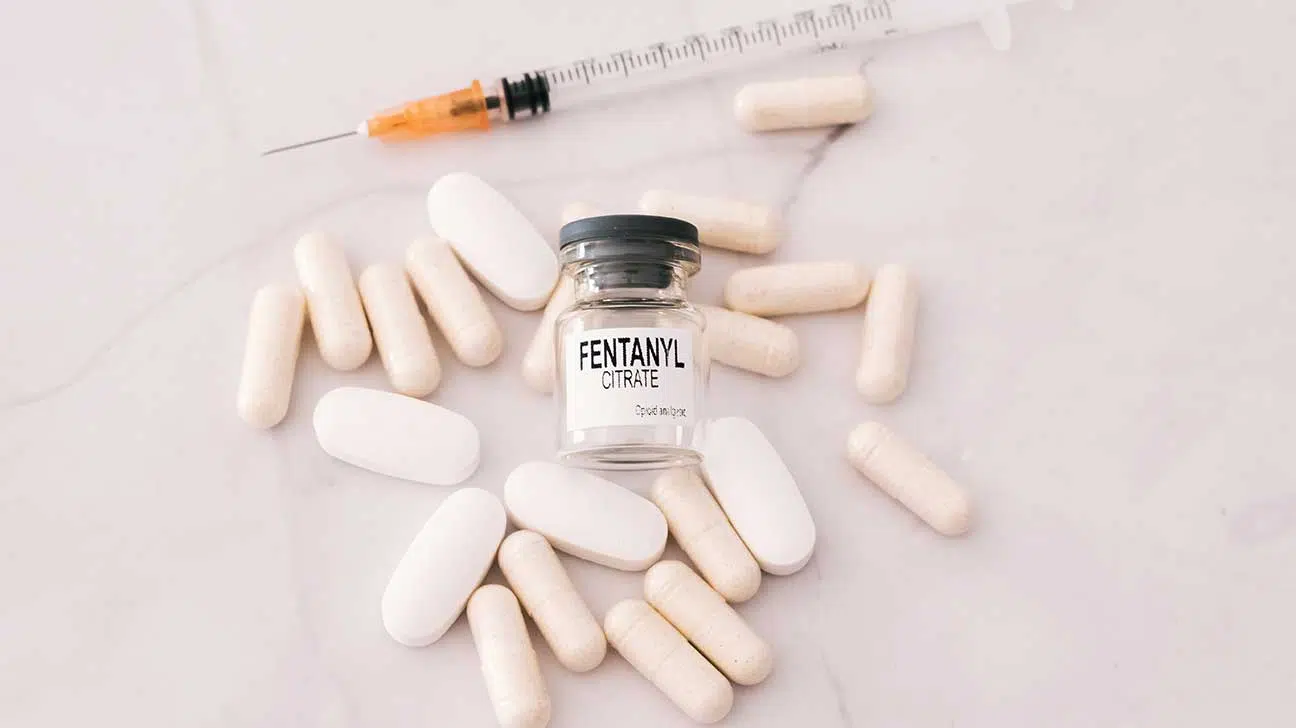
Fentanyl is an incredibly powerful synthetic opioid that is used as a prescription medication for serious chronic pain. It is 50 times stronger than heroin and 100 times stronger than morphine.
Fentanyl is used primarily in the medical industry as a painkiller and sedative, but many people also abuse it for recreational purposes.
Understanding how long a drug lasts can help people safely take medications and reduce their risk of side effects and overdose.
Does The Type Of Fentanyl Affect Its Duration?
There are many different forms of fentanyl that can be used for a variety of medical applications.
Legitimate prescription fentanyl can be found in:
- pills
- injectable solutions
- lozenges
- nasal sprays
- transdermal patches
When fentanyl is sold illegally it is more likely to be sold as tablets, powder, or on blotter paper. Illegal fentanyl is also often used as an adulterant to enhance drugs like heroin and cocaine.
Each type of fentanyl will last for a different amount of time. Drugs that are metabolized through mucus membranes will take effect much quicker than something ingested orally.
The injectables, nasal sprays, and lozenges will be felt faster than the pills or transdermal patches. Methods of abuse, such as snorting or “plugging,” also take effect faster.
How Long Do Fentanyl Effects Last?
There are a few factors that help to determine how long a fentanyl high will last. Some of these include the drug’s half-life, dosage, frequency of use, method of ingestion, and tolerance.
Fentanyl has a half-life of two to four hours, which means it takes the average person two to four hours to metabolize half of the original dose out of their system.
On average, it takes five to six half-lives to fully metabolize a drug, so fentanyl can stay in the body between 10 and 24 hours after the last dose.
While half-life is important for determining detection windows, the duration of the initial high is more closely tied to the method of abuse.
Shortest Duration
Injecting or “plugging” fentanyl has an almost immediate effect, but the resulting high only lasts a couple of hours. These methods are also the most dangerous forms of illicit use.
Moderate Duration
Taking fentanyl orally or applying it as a nasal spray has a slightly delayed effect of 15 to 30 minutes. However, the resulting high does last a little longer with an average of four to six hours.
Longest Duration
Extended-release forms, like a fentanyl lollipop or a transdermal fentanyl patch, release the drug into the body over time, so the effects last significantly longer, up to 72 hours.
Fentanyl Detection Times
Fentanyl leaves behind markers called metabolites that can still be detected after fentanyl has left the body. These can be spotted by drug tests using samples of urine, blood, saliva, or hair.
Detection times will vary based on factors like the person’s age, weight, liver health, and frequency of opioid use. Saliva tests do not consistently pick up fentanyl.
The average detection times for fentanyl are:
- between five and 48 hours for blood tests
- between 24 and 72 hours in urine tests
- up to three months in hair tests
How Long Do Fentanyl Withdrawal Symptoms Last?
Fentanyl is highly addictive due to its potency. It doesn’t take long to develop a physical dependence or to establish patterns of substance abuse.
If you’re prescribed fentanyl, it’s important to take it exactly as directed by your doctor. Fentanyl is usually a short-term prescription, but it may be prescribed for weeks or more in special cases.
People addicted to fentanyl will experience severe withdrawal symptoms if they quit “cold turkey.” Withdrawal usually begins within 12 hours of the last use and can last up to a week.
Fentanyl withdrawal can be challenging, but addiction treatment centers can provide help in the form of detox programs, mental health support, and medication-assisted treatment options.
Fentanyl withdrawal symptoms include:
- insomnia
- nausea
- diarrhea
- vomiting
- muscle and bone pain
- chills
- increased blood pressure
- elevated heart rate
- fentanyl cravings
- loss of appetite
- depression
Some of these symptoms can be life-threatening. A medical detox center can provide opioid withdrawal medications, like Suboxone or methadone, to manage symptoms and maintain safety.
What Does Fentanyl Feel Like?
All opioids and opiates work by binding themselves to opioid receptors in the regions of the central nervous system (CNS) that regulate pain and emotions.
Fentanyl is an incredibly effective form of pain relief. It also produces intense euphoria at high doses by increasing dopamine levels and stimulating the body’s reward system.
People abusing fentanyl may experience sensations of calm and well-being, but abuse comes with serious risks. Taking slightly too much can result in potentially deadly side effects.
How Long Do Fentanyl Side Effects Last?
Fentanyl’s side effects can range from moderate to severe. While severe side effects are rare with prescribed use, the risk is significantly elevated when the drug is taken in higher doses.
Most of the common side effects can set in quickly, but they only last as long as fentanyl is in the body. Side effects also tend to lessen in severity as the drug is metabolized through the system.
The most common fentanyl side effects are:
- constipation
- drowsiness
- sedation
- nausea and vomiting
- confusion
- dizziness
- headaches
- stiff muscles
Serious side effects include:
- low blood pressure
- difficulty breathing
- seizures
- unconsciousness
If you experience any of the serious side effects of fentanyl abuse, immediately call emergency medical services.
FAQs About Fentanyl
If you want more information about fentanyl and its uses, we’ve gathered some of the most common frequently asked questions below.
How Addictive Is Fentanyl?
Fentanyl is currently one of the most addictive substances in the world, even more so than heroin. Since it is synthetically produced, it has the ability to be incredibly potent.
Synthetic opioids have the highest rates of addiction, overdose, and death out of any illicit drug on the market.
How Much Does Fentanyl Cost On The Street?
Fentanyl’s street price can vary based on location and composition. Most illegal fentanyl is cut with other substances. A single dose of fentanyl averages around $2.
Fentanyl is typically sold in larger amounts. Buying a gram of fentanyl averages closer to $200.
Can You Overdose On Fentanyl?
Fentanyl is one of the most common causes of overdose deaths in the United States. It takes only a tiny amount to overdose, and it’s difficult to detect in counterfeit drugs without test strips.
If you or a loved one have an opioid addiction, carrying naloxone (Narcan) and recognizing the signs of overdose is crucial. Even a few minutes can save a life.
What Are The Treatments For Fentanyl Addiction?
After detox, a person may begin an inpatient or outpatient rehabilitation program. The most effective fentanyl addiction treatments include therapy, 12-step programs, and medication-assisted treatment (MAT).
Seeking Help For A Fentanyl Addiction
Fentanyl can provide a lot of relief to people who live with severe pain, but it also has great potential for drug abuse. Everyone who uses it should be aware of the risks involved.
If you or someone you love is experiencing a fentanyl addiction, you are not alone. There are inpatient and outpatient treatment clinics that can support you through your addiction recovery.
To learn more, call our helpline and speak to a specialist about your healthcare options.
Addiction Resource aims to provide only the most current, accurate information in regards to addiction and addiction treatment, which means we only reference the most credible sources available.
These include peer-reviewed journals, government entities and academic institutions, and leaders in addiction healthcare and advocacy. Learn more about how we safeguard our content by viewing our editorial policy.
- Centers for Disease Control and Prevention
https://www.cdc.gov/stopoverdose/fentanyl/index.html - Medical News Today
https://www.medicalnewstoday.com/articles/308156 - National Health Service UK
https://www.nhs.uk/medicines/fentanyl/ - National Institute on Drug Abuse
https://nida.nih.gov/publications/drugfacts/fentanyl


